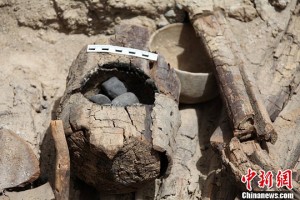 As reported recently by China TV, Chinese archeologists in Northwest China’s Xinjiang Uygyr Autonomous Region have discovered wooden braziers in excavated graves, leading them to believe that the people practiced Zoroastrianism. Zoroastrians buried a burning brazier with the dead to show their worship of fire. Archeologists also found polished stoneware in the mounds as well as eyebrow pencils used most probably by women.
As reported recently by China TV, Chinese archeologists in Northwest China’s Xinjiang Uygyr Autonomous Region have discovered wooden braziers in excavated graves, leading them to believe that the people practiced Zoroastrianism. Zoroastrians buried a burning brazier with the dead to show their worship of fire. Archeologists also found polished stoneware in the mounds as well as eyebrow pencils used most probably by women.
These newly discovered artifacts in this sparsely populated part of Pamir Plateau of China, shows that people lived, battled and created marvelous civilizations according to the researchers. However, the archeologists are also presenting a new hypothesis which remains to be proven. The mounds that are being excavated, they believe point to a civilization that practiced Zoroastrianism which could date back to more than 2500 years ago. Therefore, according to the Chinese researchers’ hypothesis, Zoroastrianism could have also originated in China and not in ancient Persia.
In 2010, as reported by several news outlets, a horse bone bearing cuneiform inscriptions apparently derived from Cyrus Cylinder was also discovered in China along with a second bone inscribed with an as yet unknown text. The bones were acquired by the Beijing Palace Museum in 1985. Their origin is unclear, but Dr. Irving Finkel of British Museum Department of the Middle East has hypothesized that they may reflect a text inscribed or written in another format (perhaps leather or clay), derived from the Cyrus Cylinder’s text, though for some reason only one twenty of the original cuneiform symbols were copied. Finkel suggested that this may indicate that the text (or even the original cylinder itself) was sent around the Persian Empire and was copied to make the bone’s inscription at some point.
If the hypothesis presented by the Chinese archeologists is true, further research is needed to find out why Zoroastrianism prospered in Persia and not in China, as evidenced by extensive monuments, artifacts, history and propagation of the religion in ancient Persia. In addition, further excavations and research in China are essential to show if they find just more than a few buried braziers which could support the new presented hypothesis by the Chinese.
Zoroastrianism and their beliefs could have indeed been transferred from ancient Persia to other parts of the world and borders of the Persian Empire as they did with inscribed cuneiforms.















